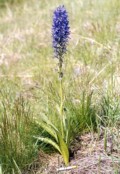|
|
Qwnu'lmkhw - Listen as Felix Aripa explains the significance of camas, with Raymond Brinkman, James Twoteeth and Kim Matheson. (recorded
and edited by John Hartman on June 4, 2001 as part of the Coeur d'Alene Tribal GIS Names-Place Project)
|
 | | Flowering of the Camas, May 1998 |
Itqhwe', camas (baked), has long been an essential food staple for the Schitsu’umsh. Sqha'wlutqhwe' is the term for raw camas. Like the water potato, prayer is first offered to the Creator, asking permission to dig the camas and that a blessing be bestowed upon those who partake of the root. A small tobacco offering might also be placed in the earth where the first bulb is removed. Dug with a tool called a pitse' (digging stick), camas is gathered in the spring and early summer season. To prepare the camas, a special pit is dug, heated with rock and wood coals and layered with particular leaves and grasses. After the skinned camas is placed in the pit, earth is piled on and logs kept burning over this earthen oven. After days of baking, the camas is ready to be removed and eaten. While today no longer part of the daily diet of the people, camas remains an important cultural food to be served at birthday celebrations, powwows, memorials and winter ceremonial dances, or just whenever a grandmother has a desire for some!
© Coeur d'Alene Tribe 2002
< previous |
next >
|








